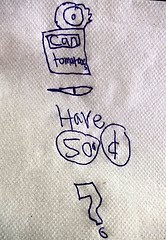
One of the moribund mysteries of KM craft is the conversational impasse that settles in around the question of who can see what.
On first blush this sounds like territorial jockeying between two rival business units. But I think the fear runs deeper while the rationale runs ... shallow. Unlike traditional competition where the enemy integrates our vulnerabilities into a nimble and customer-facing game plan these tender subjects have a lot more to do with vanity and self-preservation than with competitive advantage or go-to-market strategy.
I'm conducting a series of interviews over the coming months for KM World on SharePoint adoption. The focus is not on success but more the fear of success that sandbags so many deployments. I interviewed Marc Anderson of Sympraxis Consulting yesterday. In addition to being a SharePoint integrator Marc is a process management expert who cut his BPM teeth from the Norton Kaplan scorecarding he did with Renaissance Solutions back in the late nineties.
Storing consistently formatted documents triggered by the flow of predictable events is one of those bake-inable gains on the SharePoint adoption curve. But what happens when that reasonable goal becomes a towering expectation? Is a contract really a contract when it was called a statement of work before we merged? Is it my group or yours responsible for unpacking the backlog? Most importantly who's on the hook when our fail safe security policy takes over and "security by obscurity" is replaced by protocol and accountability?
A more interesting question isn't about permissions structures and pecking orders but how to configure SharePoint to reduce cycle times for common tasks. And those requirements extend well beyond back end administration. For instance we can move beyond search results to business results. We can deliver answers instead of documents. We can get beyond the ingrained bias that documents themselves more than the records they contain.
For example what if the golden nuggets within a large involved analysis always land in the same section or sub-clause or roman numeral addendum ad item? Microsoft didn't just add an "X" to .ppts and .xls to make a design statement or an upgrade ultimatum. They did it because XML means never having to hide behind the confinements of file formats. It means being able to chunk content so that granularity happens in the metadata -- not in the mass burial of an endless results list.
These modifications can be done without writing a stitch of XML code too by indexing lists and separating them in the results screen from the PDFs and PowerPoints in our site collection libraries. It means re-importing the familiar laundry lists that service the value propositions of most business proposals so that the value adds and situational specifics are anchored in past success and squared with the needs of the prospect being targeted. Querying against a set of tables makes imminently more sense than trying to pull and retrofit every proposal that's ever deviated from the official script since the beginning of sales cycle time.
More on this as the interviewing calendar unfolds.








